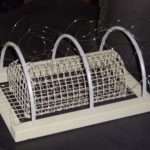For those readers that follow my column, its no secret by now that I love raptors, and as far as I’m concerned, Kansas may be the premier location to see winter hawks. Besides an influx of Red Tail hawks which are common to Kansas year-round, we get Northern Harriers, Swainson hawks on their way to Argentina for the winter, Rough-Legged hawks on their way from Canada to the western US, and Ferruginous hawks on their way to the southern US and Florida.
I first met Tommy Kinch at the now-defunct McPherson Scottish festival years ago where the Kansas Hawking Club had a booth featuring members and their birds. At that time Tommy had just caught a young Red Tail Hawk and named it “Red.” The next winter Tommy invited Joyce and I to hunt with some of the club members and their birds where we got to observe Red catch his first rabbit under Tommy’s handling. The following summer Red died in an unfortunate freak accident, leaving Tommy without a hawk. Now, I seem to have a nose for a good adventure, so that fall I sort of invited myself along to help Tommy trap another, which his falconry license and a current Kansas hunting license allow him to do.
We met Tommy at El Dorado, KS and left to drive the backroads searching for roosted hawks. The standard procedure used by falconers to accomplish this is to place some sort of live bait in a cage of some description which is covered outside with slip-knot nooses made of fish line. The trap is dropped near a hawk found sitting along the road, and if and when the bird tries to get at the bait, it becomes entangled and can be captured. The traps Tommy made and used back then employed a square 2 x 12 piece of lumber with the corners mitered off. A hole was cut through the board and rigged with a latching door. For the cage he used a kitchen strainer with the handle removed and fastened it upside down onto the piece of lumber. As many fishing lines nooses as possible were fastened to the outside of the strainer. He rigged a plastic bucket as a cage to carry gerbils for the bait. Before we left, two gerbils were put into the trap and I rode shotgun with the trap on my lap, ready to slip it out the door near any resting hawks we could find. (A hawk cannot actually get through the wire to the bait inside, so no gerbils were harmed in this adventure or the writing of this story!)
We drove the most secluded roads we could find, concentrating on those providing the best perches in the form of hedge rows or power poles. We found several red tails and slowed to drop the trap only to have them spook and fly immediately. We were heading back to town for lunch, when to our right sat a hawk on a pole high above an oil well pump just off the road. The situation was perfect! An open lane turned into the field directly across from the pump, giving the bird an easy view of the trap as I opened the pickup door and dropped it. We hurried up the road and turned around at a spot where we could see the hawk well, but the trap was not visible. Before we could even reach for binoculars or decide on a better vantage point, the hawk dove from its perch and disappeared into the grass. As I sat mesmerized by what I’d just seen, the grass in the lane came alive as the hawk flopped, desperately trying to free itself from the nooses on the trap which obviously had it ensnared. We watched impatiently for several minutes, when just as suddenly as it had plummeted toward the trap, the hawk rose from the ground and flew into the trees across the road. We sat there stunned, wondering if what we had seen had really happened! A second red tail landed on a pole just above the trap, and we waited in silence for one or both to dive again for what certainly looked like an easy lunch. Ten minutes passed with no further interest from either hawk, so when both birds finally flew, we hurried back to investigate. When the trap came into view, the problem became apparent; there in the grass lay the trap upside down, evidently flipped over by the first hawk in its struggle to escape. In that position, not only were our two brave little gerbils barely visible from above, but the nooses were rendered useless even if the hawks had persisted. After lunch we tried again, but no hawk that day.
Today, Tommy builds a different style of hawk trap known as a BC Trap (short for Bal-Chatri Noose trap) and sells them on the website www.hawktrap.com. These are built differently than the trap we used that day, but still use fishline nooses to ensnare the birds by the foot. The only winners that Saturday some years ago were the 2 little gerbils, but hey, whether the quarry is a hawk or a coyote, that’s trappin’. Continue to Explore Kansas Outdoors.
Steve can be contacted by email at stevenrgilliland@gmail.com.




